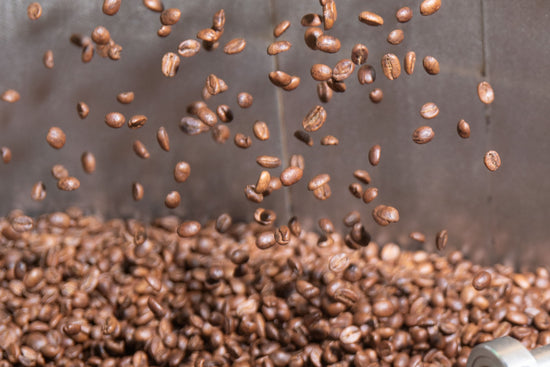How Coffee Roasting Affects Extraction with Olympia Coffee

Sourcing well-developed coffee from roasters who buy high-quality coffee will not only help you achieve a more even extraction, but it will taste the most balanced and delicious. To give you an inside look at the process of green coffee buying and coffee roasting, we interviewed the experts themselves, Oliver Stormshak (CEO and Green Coffee Buyer) and Reyna Callejo (Retail Trainer) from Olympia Coffee.
The altitude and place where a coffee is grown, the species and varietal, whether it was hand-selected or not, how it was processed (i.e., washed, natural, or honey processed), the climate, the soil, and the attention to detail by the farmer greatly affects the flavor and quality of a coffee and your shot of espresso. When roasters receive green coffee, it's a process of discovery. It starts with a raw ingredient (a coffee seed) that's packed with proteins and carbohydrates. The key to unlocking the flavor that already exists in a coffee is careful roasting.
The Coffee Roasting Process
Coffee roasting is a chemical reaction. It's the introduction of heat to an organic product (coffee), and what happens in the roaster will impact your espresso. The first stage of coffee roasting is the drying phase. Any moisture inside the beans is released— this is known as first crack. It's audible in the roaster, and most all coffees are roasted to this point.
As moisture continues to leave the bean, the plant fibers that make up the structure of the coffee will become dry, hard, and brittle as the bean begins to lose density. If roasted for longer periods of time, the plant fibers will continue to break down, and most of the oils in the coffee will push to the surface and begin to oxidize. This is known as second crack.
Note— there isn’t anything wrong with an oily coffee bean. The only thing it means for you as a barista is you’ll need to be more intentional about cleaning your grinder. Oil on the beans will coat the burrs collecting coffee grounds and potentially jam the grinder if not cleaned regularly.
The heat of the roaster will begin to reduce the complex sugars in coffee into simpler sugars, making them easier to taste. As the roast develops, some of these sugars will begin to caramelize, creating a nutty, caramel aroma apparent in most well-roasted coffees.
- If a roast is pushed too far, these sugars will carbonize, and the flavor will change from sweet and complex to burnt and smoky. As the heat increases, many of the acids in the coffee will also break down. These coffees are very light and airy.
- If a roast is stopped too early, there will be an abundance of acids in the coffee, and the coffee will be much denser.
(Think about how these coffees would go through a grinder— entirely different!)
There is not an ideal roast level for espresso. It’s totally up to you what you prefer.
The Roast Date
After coffee is roasted, it begins to release carbon dioxide gas generated during the roasting process and remains inside the bean's cell structure. This gas is released slowly over time, when ground, and when water is introduced to coffee. To a shot of espresso, this is your crema. The older your coffee is, the more time it’s had to release co2, and therefore, it will leave you with a shot of espresso with little to no crema and brew times that lead to watery, bland tasting shots. Ideally, you’re using coffee between 5 and 14 days off roast so that you can achieve consistency and obtain a shot full of crema. Remember, to keep your coffee at its freshest for the longest amount of time, store it in an airtight container away from light, moisture, fluctuating or extreme temperatures, and most importantly: oxygen.
Roasting changes the density and solubility of coffee, which will affect how you need to adjust your grind and your water temperature. Keeping in mind with different roasts is that as a coffee bean is roasted, it becomes more porous, and certain compounds break down. Because the bean becomes less dense as it's roasted, it becomes easier for water to pull the flavorful and dissolvable solids out of the grounds. So darker roasts are more soluble than lighter roasts. The added density of a lightly roasted coffee means that water will have a hard time dissolving flavor into the coffee. So, you’ll need to expand the surface area by grinding finer to aid in extraction. Darker roasted coffees can be ground coarser to achieve a similar extraction. Keep this in mind when switching coffees. Your grind will most likely need to change— even with subtle roast level variances.
Leave questions and comments below or email us at hello@clivecoffee.com.